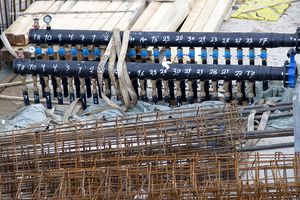Alternative Energies vs. Natural Gas & Co
- Topic
- Inspiration & Information
- Date
- 17.10.2022
Why is sustainable real estate development so important to us? Because we want our children and grandchildren to have a livable planet. And also because sustainability results in the lowest possible operating costs for users and the best possible financial yields for future owners.
We recently showed our project The Blend — which uses a geothermal heat pump to heat — to an investor. She asked whether it actually pays off financially or if we had been required to use geothermal because of the ban on natural gas boilers in new buildings that will go into effect in 2023.
The answer is:
We build sustainably because we believe in it and because it benefits the future users and owners. Sustainable and efficient energy systems are a central part of our business model.
The installation of a natural gas heating system costs about 40–50 euros/m² in larger residential buildings, depending on the size of the apartment and prices at time of order. The costs to install an alternative energy concept are around 80–90/m², i.e. about EUR 40/m² more. If you look at this in relation to the total investment for a new building, we are talking about less than one percent additional costs. What is really exciting, however, is the point of view of future owners, who will see a significant increase in additional income generated and overall property value.

The graph above shows the monthly additional rental income from an apartment in Vienna from October 2021 to September 2022 when heated with alternative energy instead of natural gas. About a year ago, the additional yield/m² was already around EUR 0.65 per month, or EUR 7.6 per year. The war in Ukraine and the rise in gas prices has caused these numbers to increase by about 30%.
But why only 30%? Didn’t the price of natural gas rise a lot more than that?
The reason lies in the “principle of merit order”, a topic recently often heard in the media, which ties the price of electricity to the price of gas. Heat pumps need electricity to run, meaning that gas price increases are only partially reflected in the additional costs. If this principle really is done away with at some point, the added revenue will also increase. Even so, the current return on investment is EUR 12 per annum (additional income)/EUR 40 (additional investment) = 30%, or roughly ten times higher than the typical return on an apartment in Vienna. We cannot and do not want to let this immense potential simply go to waste.
Does this mean that the returns are at the expense of future tenants? Not at all! Due to the dramatic price increases in natural gas in recent months, the additional costs of gas heating are greater than the higher rent prices. This means that everyone involved benefits from using alternative energy sources.
A Transition with challenges...
We assume that many developers will increasingly be installing alternative energy systems in the future when building new structures. It is, however, a bit more difficult with old buildings, where conditions are often anything but simple.
- Is there enough space in the basement to install a pellet heater?
- Is there a way to put a heat pump on the roof or in the courtyard?
- Is it possible to do deep drilling on the property?
- Is there a district heating connection in the vicinity, and does it have capacity?
- And what if the tenants of an apartment building who have long-term rental contracts simply refuse to accept the upgrades because they have been heating decentrally with a wide variety of systems (natural gas, oil, electric, wood-burning stoves) for decades, and they want to keep it that way and there’s no legal way to require them to shift to a new centralized system?
There are a number of challenges to overcome when shifting to alternative energy sources in old buildings.
Better, more livable, more rewarding!
Of course, the issue of energy efficiency goes well beyond choosing an energy source. Façade choice in particular, but also floor plan and installations have a tremendous impact on energy consumption. Our specialists work hard every day to improve our projects for future users and owners—making it better, more livable, and more rewarding.








